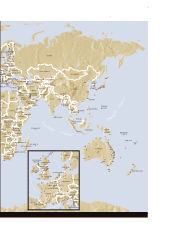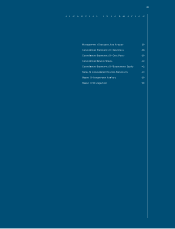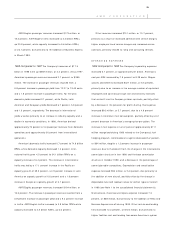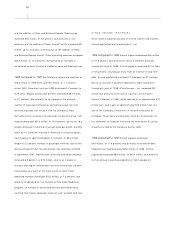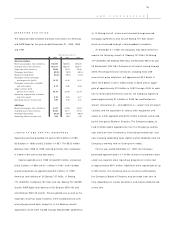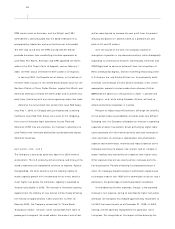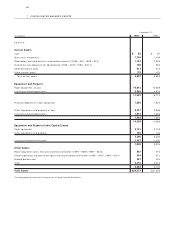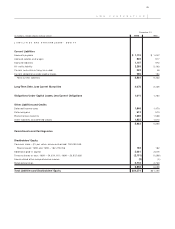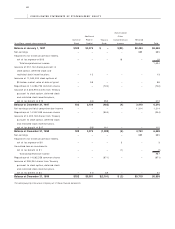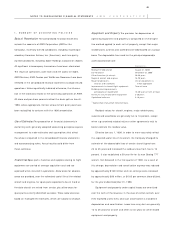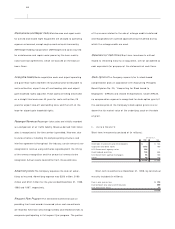American Airlines 1999 Annual Report Download - page 37
Download and view the complete annual report
Please find page 37 of the 1999 American Airlines annual report below. You can navigate through the pages in the report by either clicking on the pages listed below, or by using the keyword search tool below to find specific information within the annual report.
36
December 31, 1999. Comparatively, based on projected 1999 fuel
usage, such an increase would have resulted in an increase to
aircraft fuel expense of approximately $73 million in 1999, net of
fuel hedge instruments outstanding at December 31, 1998. The
change in market risk is due primarily to the increase in fuel prices.
As of December 31, 1999, the Company had hedged approxi-
mately 48 percent of its 2000 fuel requirements and approximately
10 percent of its 2001 fuel requirements, compared to approxi-
mately 48 percent of its 1999 fuel requirements and 19 percent of
its 2000 fuel requirements hedged at December 31, 1998.
Foreign Currency The Company is exposed to the effect of
foreign exchange rate fluctuations on the U.S. dollar value of
foreign currency-denominated operating revenues and expenses.
The Company’s largest exposure comes from the Japanese yen,
British pound, Canadian dollar, Euro and various Latin and South
American currencies. The Company uses options to hedge a
portion of its anticipated foreign currency-denominated net cash
flows. The result of a uniform 10 percent strengthening in the
value of the U.S. dollar from December 31, 1999 and 1998 levels
relative to each of the currencies in which the Company has
foreign currency exposure would result in a decrease in operating
income of approximately $39 million and $22 million for the
years ending December 31, 2000 and 1999, respectively, net of
hedge instruments outstanding at December 31, 1999 and 1998,
due to the Company’s foreign-denominated revenues exceeding
its foreign-denominated expenses. This sensitivity analysis was
prepared based upon projected 2000 and 1999 foreign currency-
denominated revenues and expenses as of December 31, 1999 and
1998. Furthermore, this calculation assumes that each exchange
rate would change in the same direction relative to the U.S. dollar.
Interest The Company’s earnings are also affected by changes
in interest rates due to the impact those changes have on
its interest income from cash and short-term investments and
its interest expense from variable-rate debt instruments. The
Company has variable-rate debt instruments representing approx-
imately 21 percent and six percent of its total long-term debt,
respectively, at December 31, 1999 and 1998, and interest rate
swaps on notional amounts of approximately $696 million and
$1.1 billion, respectively, at December 31, 1999 and 1998. If
interest rates average 10 percent more in 2000 than they did at
December 31, 1999, the Company’s interest expense would
increase by approximately $10 million and interest income from
cash and short-term investments would increase by approximately
$11 million. In comparison, at December 31, 1998, the Company
estimated that if interest rates averaged 10 percent more in 1999
than they did at December 31, 1998, the Company’s interest
expense would have increased by approximately $6 million and
interest income from cash and short-term investments would
have increased by approximately $8 million. These amounts are
determined by considering the impact of the hypothetical interest
rates on the Company’s variable-rate long-term debt, interest rate
swap agreements, and cash and short-term investment balances
at December 31, 1999 and 1998.
Market risk for fixed-rate long-term debt is estimated as the
potential increase in fair value resulting from a hypothetical 10
percent decrease in interest rates, and amounts to approximately
$156 million and $96 million as of December 31, 1999 and
1998, respectively. The fair values of the Company’s long-term
debt were estimated using quoted market prices or discounted
future cash flows based on the Company’s incremental borrowing
rates for similar types of borrowing arrangements.


